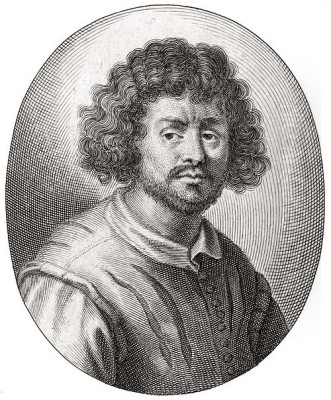
Claude Gellée, known to the world as Claude Lorrain, stands as one of the most influential and admired landscape painters in the history of Western art. Born around 1600 in the Duchy of Lorraine, then an independent state bordering France, he spent almost his entire adult life in Rome, capturing the surrounding countryside and reimagining it through a lens of poetic idealism. Active during the vibrant Baroque era, Claude did not merely paint landscapes; he elevated the genre, imbuing it with a sense of timeless beauty, serene harmony, and a profound sensitivity to the effects of light that would resonate with artists and connoisseurs for centuries to come. His work, while rooted in observation, transcends mere topography to create pastoral visions that continue to enchant viewers today.
From Lorraine to Rome: Early Life and Training
Claude Gellée's beginnings were humble and marked by early hardship. Born in the small village of Chamagne in Lorraine, precise records of his birth year vary slightly, with sources suggesting 1600, or perhaps 1604 or 1605. Most scholars favor the earlier date. Orphaned at a young age, he reportedly went to live with an elder brother, a woodworker possibly specializing in inlay (marquetry), in Freiburg, Germany. This early exposure to craft may have instilled a sense of precision, though his path lay elsewhere.
Tradition holds that Claude was not academically inclined, perhaps struggling with reading and writing. Seeking opportunity, he made his way to Italy, the artistic heart of Europe. His initial years in Rome were challenging; one account suggests he worked as a pastry cook or baker's apprentice to support himself. This period, however difficult, placed him in the environment where his true calling would emerge.
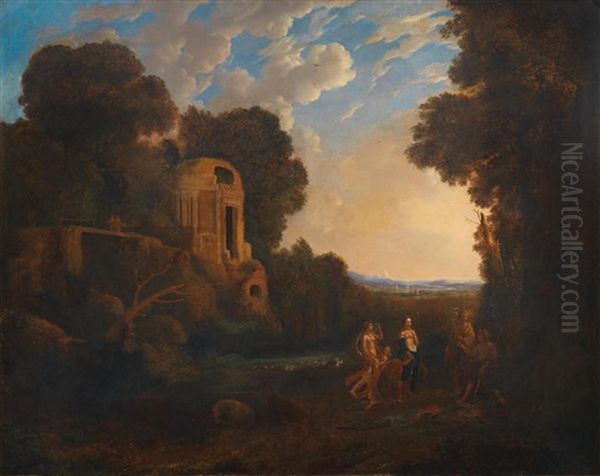
His artistic breakthrough came through apprenticeships. He entered the studio of Agostino Tassi, a painter known for his illusionistic architectural frescoes and landscape views. Tassi, though a somewhat turbulent character (famously involved in the trial concerning Artemisia Gentileschi), was a skilled practitioner of perspective and decorative schemes, knowledge from which Claude undoubtedly benefited. He also spent time studying with Goffredo Wals, a German painter based in Naples, known for his small, meticulously rendered circular landscapes that emphasized light and atmosphere. These formative experiences provided Claude with the technical grounding and artistic exposure necessary to develop his own unique vision.
Rome: The Artistic Crucible
By the mid-1620s, after a brief return trip to Lorraine where he assisted Claude Deruet with fresco decorations in Nancy, Claude Lorrain settled permanently in Rome. Seventeenth-century Rome was a dynamic hub, attracting artists from all over Europe. It was a city steeped in classical antiquity, Renaissance grandeur, and the dramatic energy of the Baroque, fostered by powerful patrons, including the papacy and noble families. This environment was crucial for Claude's development.
He established his studio and began building his reputation. Importantly, he became part of a community of artists. Among his contemporaries in Rome was the great French classical painter Nicolas Poussin. Though their artistic temperaments differed significantly – Poussin emphasizing historical and mythological narrative, intellectual rigor, and clear, structured compositions, while Claude prioritized atmosphere, light, and lyrical feeling – they were reportedly neighbors and acquaintances. One anecdote suggests they shared walks in the Roman Campagna and perhaps enjoyed wine together, hinting at a collegial relationship despite their distinct artistic paths. Poussin himself drew inspiration from Renaissance masters like Titian and Raphael, contributing to the rich classical undercurrent in Roman art that Claude also absorbed, albeit in his own way.
Forging the Ideal Landscape
Claude Lorrain's genius lay in his creation of the "ideal landscape." His paintings are rarely exact depictions of specific locations. Instead, he absorbed the features of the Roman Campagna – its rolling hills, meandering rivers, picturesque ruins, and distinctive umbrella pines – and synthesized them into harmonious, balanced compositions that evoke a sense of peace, nostalgia, and pastoral perfection. His landscapes are often inhabited by small figures drawn from the Bible, mythology, or pastoral poetry, such as shepherds, nymphs, or classical heroes.
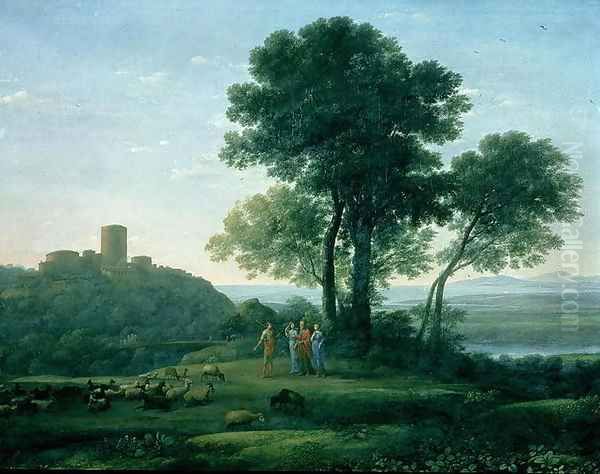
Unlike history painters where the figures dominate, in Claude's work, these figures are subordinate to the vastness and beauty of the natural setting. They serve to establish a mood or theme – often one of Arcadian tranquility or elegiac reflection – rather than to enact a dramatic narrative. Works like The Judgment of Paris or Jacob with Laban and His Daughters exemplify this approach; the titular stories unfold within expansive, luminous landscapes that are the true protagonists of the canvases. The landscape itself becomes the primary subject, designed to elicit an emotional and aesthetic response from the viewer.
His compositional structure often relies on established principles: framing elements like trees or architecture in the foreground, leading the eye through receding planes towards a distant, light-filled horizon. He masterfully employed aerial perspective, softening colors and details in the distance to create a convincing illusion of depth and space. This careful construction, combined with his sensitivity to natural forms, resulted in paintings that felt both ordered and organic, idealized yet rooted in observation. His approach contrasted with the wilder, more dramatic landscapes of contemporaries like Salvator Rosa, who emphasized untamed nature and sublime terror.
The Poetry of Light
Perhaps Claude Lorrain's most defining characteristic is his unparalleled mastery of light. He was fascinated by the subtle gradations of light and atmosphere throughout the day, particularly the warm, golden light of sunrise and sunset. His paintings are often suffused with a soft, hazy radiance emanating from a low sun, casting long shadows and unifying the composition with a palpable sense of atmosphere. The sky is never mere background; it is an active element, filled with luminous clouds and delicate transitions of color.
He achieved these effects through meticulous observation and technique. He famously spent hours sketching outdoors in the Roman countryside, studying the effects of light on the landscape. An anecdote, possibly apocryphal but indicative of his methods, suggests he used a "Claude Glass" – a small, slightly convex, darkened mirror – to help him abstract the landscape into broader tones and simplified compositions, capturing the essential play of light and shadow. This dedication to capturing natural light effects set him apart and became a hallmark of his style. His handling of light was not the dramatic, spotlighting chiaroscuro seen in the works of Caravaggio, but rather a gentle, pervasive luminosity that created mood and unified the scene.
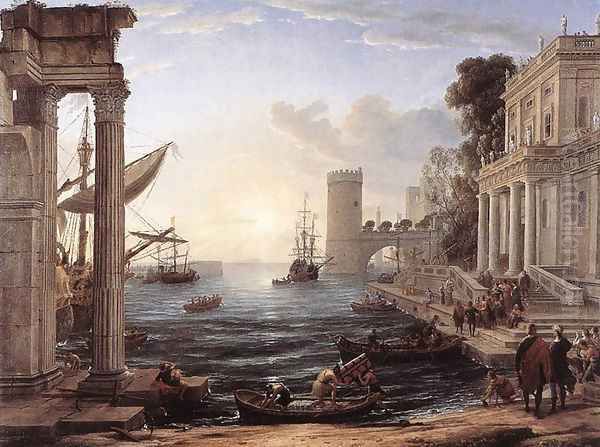
His ability to render light was so central to his art that it often dictates the entire feeling of a painting. Whether depicting a bustling port scene at sunrise or a tranquil pastoral vista at dusk, the specific quality of light shapes the viewer's experience, evoking feelings of serenity, nostalgia, or gentle melancholy. This focus on light as an expressive element was revolutionary and deeply influenced subsequent generations of artists.
Signature Works and the Book of Truth
Over his long career, Claude Lorrain produced a significant body of work, highly sought after by popes, cardinals, aristocrats, and monarchs across Europe, including Pope Urban VIII and Philip IV of Spain. Among his most celebrated paintings are harbor scenes, often depicting classical or imaginary ports bathed in morning or evening light, filled with ships and small figures engaged in daily activities. Seaport with the Embarkation of the Queen of Sheba (National Gallery, London) is a prime example of this genre, showcasing his skill in complex composition, architectural rendering, and atmospheric effects.
His pastoral landscapes, like Landscape with the Marriage of Isaac and Rebekah (also known as 'The Mill', National Gallery, London), present idyllic visions of the countryside, often featuring mythological or biblical figures seamlessly integrated into the serene setting. The work mentioned in the initial notes as Delphi Painting likely refers to a work such as Landscape with Apollo and the Cumaean Sibyl, which beautifully integrates classical architecture and figures into a sweeping, idealized landscape, demonstrating his understanding of combining nature and human elements. The Judgment of Paris and Jacob with Laban and His Daughters further illustrate his ability to use narrative subjects as anchors within his expansive landscape visions.
To protect his work from the numerous forgeries and imitations that quickly appeared due to his popularity, Claude meticulously documented his finished paintings in a volume he called the Liber Veritatis (Book of Truth). Started around 1635, this book contains drawings, executed in pen and wash, corresponding to nearly 200 of his paintings, often with notes on the back indicating the patron or destination. This remarkable record served as an authenticating catalogue during his lifetime and remains an invaluable resource for art historians today, offering insights into his working methods and chronology.
Beyond the Canvas: Claude as Etcher
While renowned for his paintings, Claude Lorrain was also a highly accomplished etcher. He produced around forty-four etchings between roughly 1630 and 1663. These prints, often based on his painted compositions or related landscape studies, allowed his work to reach a wider audience. His etchings display the same sensitivity to light, atmosphere, and compositional harmony found in his paintings.
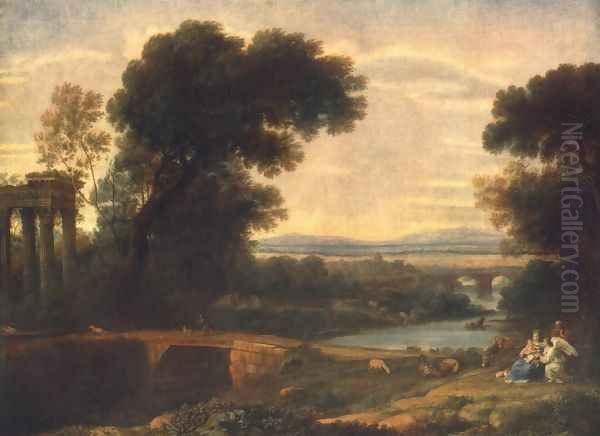
He masterfully exploited the etching medium's potential for fine lines and tonal variations to capture delicate atmospheric effects. Works like Le Bouvier (The Cowherd) demonstrate his ability to translate the luminous qualities of his paintings into black and white. His prints were admired and collected in their own right and further contributed to the dissemination of his style, influencing other printmakers and painters. His dedication to this medium parallels that of other great Baroque artists like Rembrandt, who also explored the expressive possibilities of etching.
A Quiet Life in Rome
Despite his fame and success, Claude Lorrain appears to have lived a relatively quiet and modest life, dedicated primarily to his art. Contemporary accounts describe him as a man of integrity and kindness, though perhaps somewhat reserved. The anecdote about his pricing – charging patrons for the landscape and offering the figures for free – while likely humorous exaggeration, reflects both his own assessment of where his true talent lay and perhaps a gentle self-deprecation regarding his figure-painting skills, which some critics found less assured than his landscapes.
He never married and had no children of his own. In his later years, particularly after suffering from gout, which increasingly affected his health, he reportedly lived with his niece, Agnes. Music seems to have been a source of pleasure and relaxation for him. He remained productive into old age, his later works often characterized by an even greater refinement and a more ethereal, silvery light.
Upon his death on November 23, 1682, he was buried in the church of Santissima Trinità dei Monti in Rome. His will included bequests of paintings, indicating his connections to patrons and friends, such as the prominent Rospigliosi family. He left behind a legacy not just of beautiful objects, but of a new way of seeing and representing the natural world.
Waves of Influence: The Dutch Connection
Claude Lorrain's impact was felt quickly, even during his lifetime. Northern European artists working in Rome were particularly receptive to his style. Dutch painters like Jan Both and Herman van Swanevelt spent significant time in Italy and absorbed Claude's approach to light, composition, and idealized scenery.
Returning to the Netherlands, these artists, often referred to as the "Italianates," introduced this sunnier, more pastoral style of landscape painting, which offered a contrast to the more typically Dutch focus on local topography and realism. While Dutch masters like Jacob van Ruisdael depicted the specific character of the northern landscape, the Italianates brought a touch of Arcadian warmth and classical harmony inspired by Claude and the Roman Campagna. This influence enriched the diversity of Dutch Golden Age painting.
Shaping the British Vision
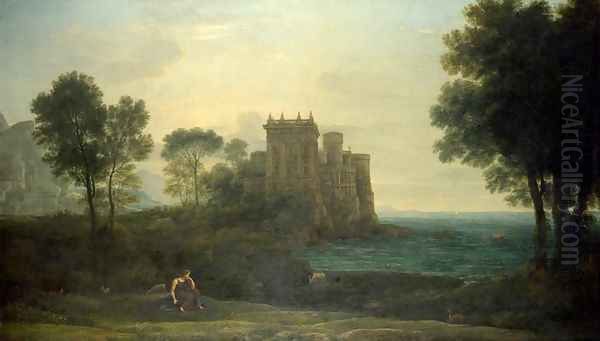
Nowhere was Claude Lorrain's influence more profound or long-lasting than in Great Britain. From the early 18th century onwards, British aristocrats undertaking the Grand Tour avidly collected his paintings, bringing them back to adorn their country estates. Claude's idealized landscapes came to represent the epitome of pictorial beauty and harmony.
His influence extended beyond painting into the realm of landscape gardening. Designers like Lancelot "Capability" Brown and William Kent sought to recreate Claudian vistas in the actual grounds of English estates, shaping parks and gardens to resemble the harmonious compositions of his paintings, complete with serpentine lakes, strategically placed clumps of trees, and classical follies. The English landscape garden is, in many ways, a three-dimensional realization of Claude's artistic vision.
British painters were deeply affected. Richard Wilson, often called the "father of British landscape painting," directly adapted Claude's style to Welsh and Italian scenery. Later, the two giants of British Romantic landscape painting, John Constable and J.M.W. Turner, both acknowledged their debt to Claude, even while forging their own revolutionary paths. Constable admired Claude's naturalism and handling of light, while Turner engaged in a lifelong dialogue with him, seeking to emulate and ultimately surpass his mastery of light and atmosphere. Turner famously bequeathed two of his own paintings to the National Gallery in London on the condition that they hang alongside works by Claude. Even poets like John Keats were inspired by the "fairyland" quality of Claude's idealized world.
Echoes in France and Beyond
While perhaps less overwhelmingly dominant than in Britain, Claude's influence was also significant in his native France and elsewhere in Europe. French artists absorbed his lessons in landscape composition and atmospheric effect. Elements of his pastoral idealism can be detected in the fêtes galantes of Jean-Antoine Watteau, whose depictions of aristocratic leisure often take place in park-like settings reminiscent of Claude's idealized nature. Even academically inclined artists associated with the French Royal Academy, such as Charles Le Brun (though more aligned with Poussin's classicism), operated within an artistic environment where Claude's reputation as a landscape master was well-established.
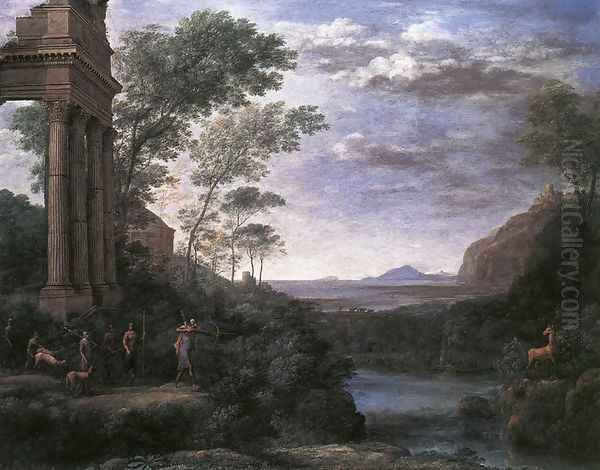
By the 18th and 19th centuries, Claude's status was firmly cemented. He was frequently discussed by art theorists and critics, and his name became synonymous with the highest achievements in landscape painting. His reputation placed him in the pantheon of Baroque masters, sometimes compared in stature, within the realm of landscape, to figures like Peter Paul Rubens or Anthony van Dyck in history painting and portraiture.
Elevating the Landscape Genre
Claude Lorrain's most enduring contribution to art history is arguably his role in establishing landscape painting as a major, independent genre. Before the 17th century, landscape often served primarily as a backdrop for religious or historical scenes. While artists of the Northern Renaissance and earlier Italian painters had shown interest in depicting nature, it was Claude, along with contemporaries like Poussin in Rome and Dutch specialists in the Netherlands, who truly elevated landscape to a subject worthy of depiction in its own right.
He demonstrated that landscape painting could convey profound emotion, intellectual depth, and aesthetic beauty without relying on dominant narrative content. His focus on mood, light, and the poetic interpretation of nature opened up new possibilities for artists. He created a classical landscape tradition that offered an alternative to the more topographical or purely naturalistic approaches, a tradition that valued harmony, order, and idealized beauty drawn from the careful observation of the natural world.
Enduring Reputation
Claude Lorrain's reputation has remained remarkably consistent over the centuries. While artistic tastes fluctuate, his mastery of light, his ability to evoke a sense of peace and timelessness, and the sheer beauty of his compositions continue to be admired. He is recognized as a pivotal figure in the Baroque period and a foundational artist for the development of landscape painting in Europe.
His works are treasured holdings in major museums worldwide, from the Louvre in Paris and the Prado in Madrid to the National Gallery in London and the Metropolitan Museum of Art in New York. His Liber Veritatis stands as a unique testament to an artist's careful management of his output and reputation. He remains the quintessential painter of the ideal landscape, an artist who found poetry in the Roman countryside and translated it onto canvas with unparalleled sensitivity and skill.
Conclusion

Claude Lorrain, the humble boy from Chamagne who became Rome's most celebrated landscape painter, left an indelible mark on the history of art. Through his dedication to observing nature, his profound understanding of light, and his ability to synthesize reality into harmonious, idealized visions, he created a world on canvas that was both deeply personal and universally appealing. He not only mastered the art of landscape painting but fundamentally shaped its trajectory, influencing generations of artists and defining for many the very essence of pastoral beauty. His luminous, tranquil vistas continue to offer viewers a glimpse into an Arcadian world, a testament to the enduring power of his art.